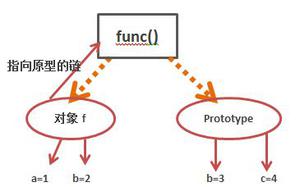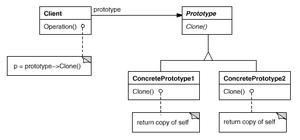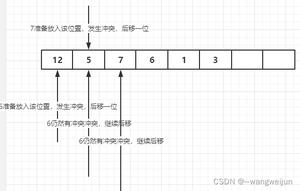谈谈js中的prototype及prototype属性解释和常用方法
prototype是javascript中笔记难理解的一部分内容,下面通过几个关键知识点给大家讲解js中的prototype。具体内容请看下文详情。
1 原型法设计模式
在.Net中可以使用clone()来实现原型法
原型法的主要思想是,现在有1个类A,我想要创建一个类B,这个类是以A为原型的,并且能进行扩展。我们称B的原型为A。
2 javascript的方法可以分为三类:
a 类方法
b 对象方法
c 原型方法
例子:
function People(name)
{
this.name=name;
//对象方法
this.Introduce=function(){
alert("My name is "+this.name);
}
}
//类方法
People.Run=function(){
alert("I can run");
}
//原型方法
People.prototype.IntroduceChinese=function(){
alert("我的名字是"+this.name);
}
//测试
var p1=new People("Windking");
p1.Introduce();
People.Run();
p1.IntroduceChinese();
3 obj1.func.call(obj)方法
意思是将obj看成obj1,调用func方法
好了,下面一个一个问题解决:
prototype是什么含义?
javascript中的每个对象都有prototype属性,Javascript中对象的prototype属性的解释是:返回对象类型原型的引用。
A.prototype = new B();
理解prototype不应把它和继承混淆。A的prototype为B的一个实例,可以理解A将B中的方法和属性全部克隆了一遍。A能使用B的方法和属性。这里强调的是克隆而不是继承。可以出现这种情况:A的prototype是B的实例,同时B的prototype也是A的实例。
先看一个实验的例子:
function baseClass()
{
this.showMsg = function()
{
alert("baseClass::showMsg");
}
}
function extendClass()
{
}
extendClass.prototype = new baseClass();
var instance = new extendClass();
instance.showMsg(); // 显示baseClass::showMsg
我们首先定义了baseClass类,然后我们要定义extentClass,但是我们打算以baseClass的一个实例为原型,来克隆的extendClass也同时包含showMsg这个对象方法。
extendClass.prototype = new baseClass()就可以阅读为:extendClass是以baseClass的一个实例为原型克隆创建的。
那么就会有一个问题,如果extendClass中本身包含有一个与baseClass的方法同名的方法会怎么样?
下面是扩展实验2:
function baseClass()
{
this.showMsg = function()
{
alert("baseClass::showMsg");
}
}
function extendClass()
{
this.showMsg =function ()
{
alert("extendClass::showMsg");
}
}
extendClass.prototype = new baseClass();
var instance = new extendClass();
instance.showMsg();//显示extendClass::showMsg
实验证明:函数运行时会先去本体的函数中去找,如果找到则运行,找不到则去prototype中寻找函数。或者可以理解为prototype不会克隆同名函数。
那么又会有一个新的问题:
如果我想使用extendClass的一个实例instance调用baseClass的对象方法showMsg怎么办?
答案是可以使用call:
extendClass.prototype = new baseClass();
var instance = new extendClass();
var baseinstance = new baseClass();
baseinstance.showMsg.call(instance);//显示baseClass::showMsg
这里的baseinstance.showMsg.call(instance);阅读为“将instance当做baseinstance来调用,调用它的对象方法showMsg”
好了,这里可能有人会问,为什么不用baseClass.showMsg.call(instance);
这就是对象方法和类方法的区别,我们想调用的是baseClass的对象方法
最后,下面这个代码如果理解清晰,那么这篇文章说的就已经理解了:
<script type="text/javascript">
function baseClass()
{
this.showMsg = function()
{
alert("baseClass::showMsg");
}
this.baseShowMsg = function()
{
alert("baseClass::baseShowMsg");
}
}
baseClass.showMsg = function()
{
alert("baseClass::showMsg static");
}
function extendClass()
{
this.showMsg =function ()
{
alert("extendClass::showMsg");
}
}
extendClass.showMsg = function()
{
alert("extendClass::showMsg static")
}
extendClass.prototype = new baseClass();
var instance = new extendClass();
instance.showMsg(); //显示extendClass::showMsg
instance.baseShowMsg(); //显示baseClass::baseShowMsg
instance.showMsg(); //显示extendClass::showMsg
baseClass.showMsg.call(instance);//显示baseClass::showMsg static
var baseinstance = new baseClass();
baseinstance.showMsg.call(instance);//显示baseClass::showMsg
</script>
ps:js的Prototype属性 解释及常用方法
函数:原型
每一个构造函数都有一个属性叫做原型(prototype,下面都不再翻译,使用其原文)。这个属性非常有用:为一个特定类声明通用的变量或者函数。
prototype的定义
你不需要显式地声明一个prototype属性,因为在每一个构造函数中都有它的存在。你可以看看下面的例子:
Example PT1
CODE:
function Test()
{
}
alert(Test.prototype); // 输出 "Object"
给prototype添加属性
就如你在上面所看到的,prototype是一个对象,因此,你能够给它添加属性。你添加给prototype的属性将会成为使用这个构造函数创建的对象的通用属性。
例如,我下面有一个数据类型Fish,我想让所有的鱼都有这些属性:livesIn="water"和price=20;为了实现这个,我可以给构造函数Fish的prototype添加那些属性。
Example PT2
CODE:
function Fish(name, color)
{
this.name=name;
this.color=color;
}
Fish.prototype.livesIn="water";
Fish.prototype.price=20;
接下来让我们作几条鱼:
CODE:
var fish1=new Fish("mackarel", "gray");
var fish2=new Fish("goldfish", "orange");
var fish3=new Fish("salmon", "white");
再来看看鱼都有哪些属性:
CODE:
for (int i=1; i<=3; i++)
{
var fish=eval_r("fish"+i); // 我只是取得指向这条鱼的指针
alert(fish.name+","+fish.color+","+fish.livesIn+","+fish.price);
}
输出应该是:
CODE:
"mackarel, gray, water, 20"
"goldfish, orange, water, 20"
"salmon, white water, 20"
你看到所有的鱼都有属性livesIn和price,我们甚至都没有为每一条不同的鱼特别声明这些属性。这时因为当一个对象被创建时,这个构造函数 将会把它的属性prototype赋给新对象的内部属性__proto__。这个__proto__被这个对象用来查找它的属性。
你也可以通过prototype来给所有对象添加共用的函数。这有一个好处:你不需要每次在构造一个对象的时候创建并初始化这个函数。为了解释这一点,让我们重新来看Example DT9并使用prototype来重写它:
用prototype给对象添加函数
Example PT3
CODE:
function Employee(name, salary)
{
this.name=name;
this.salary=salary;
}
Employee.prototype.getSalary=function getSalaryFunction()
{
return this.salary;
}
Employee.prototype.addSalary=function addSalaryFunction(addition)
{
this.salary=this.salary+addition;
}
我们可以象通常那样创建对象:
CODE:
var boss1=new Employee("Joan", 200000);
var boss2=new Employee("Kim", 100000);
var boss3=new Employee("Sam", 150000);
并验证它:
CODE:
alert(boss1.getSalary()); // 输出 200000
alert(boss2.getSalary()); // 输出 100000
alert(boss3.getSalary()); // 输出 150000
这里有一个图示来说明prototype是如何工作的。这个对象的每一个实例(boss1, boss2, boss3)都有一个内部属性叫做__proto__,这个属性指向了它的构造器(Employee)的属性prototype。当你执行 getSalary或者addSalary的时候,这个对象会在它的__proto__找到并执行这个代码。注意这点:这里并没有代码的复制(和 Example DT8的图表作一下对比)。
以上是 谈谈js中的prototype及prototype属性解释和常用方法 的全部内容, 来源链接: utcz.com/z/351262.html







